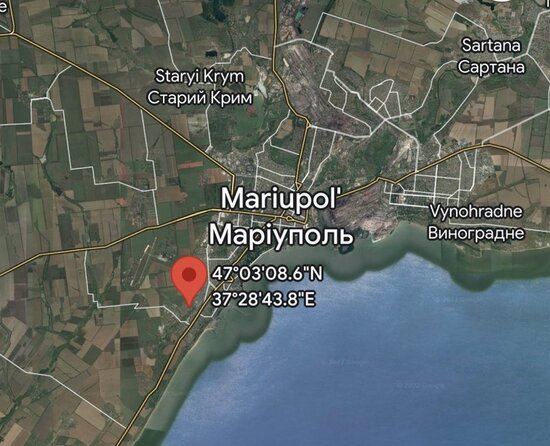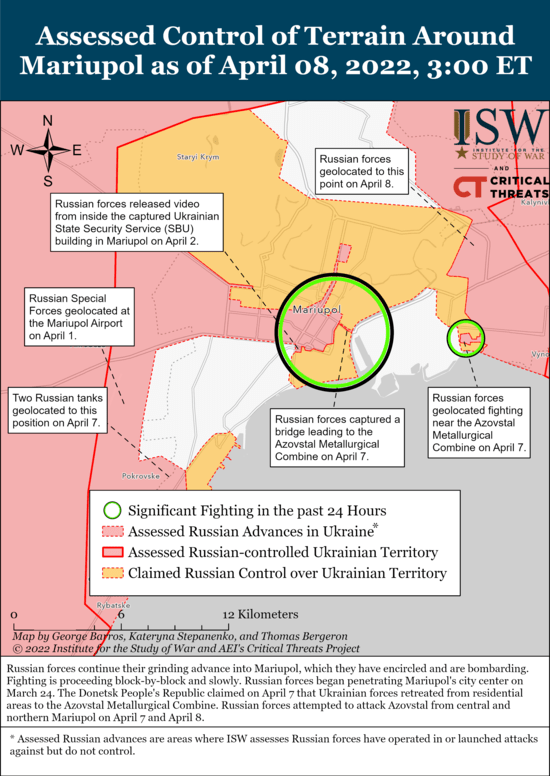Ukraine update: Cut off and isolated but against all odds, Mariupol continues to resist
This post was originally published on this site
Mariupol should have been taken on the first day of the war. Situated in Ukraine’s far southeastern corner, distant from other major urban centers and supply lines, directly south of the rebel-occupied Donbas separatist region, mostly Russian speaking, and just across the Azov Sea from Russia itself, it never should’ve been competitive.
Yet after six weeks of full blockade and unimaginable devastation, Mariupol continues to resist. How is that possible? We won’t know the full story until after the war, but what we know (and can guess at) paints an incredible picture.
The city was defended by two main forces. The first was Ukrainian marines. But the more (in)famous was the Azov Battalion, a paramilitary force of far-right extremist neo-Nazis who were founded in 2014. What else happened in 2014? Russia’s annexation of the Crimean peninsula and the start of the separatist war in Eastern Ukraine. In fact, it was the Azov Battalion that retook Mariupol after pro-Russian forces (and likely Russians themselves) occupied the city. It is estimated that at the start of the Russian invasion, Azov had around 900 members, though those numbers have swelled since. Ironically, Russia’s war has proven a boon to far-right militants, even as it uses Azov’s existence as justification for its entire war.
Ukraine, led by a Jewish president, clearly decided that the enemy of their enemy is their friend—for now—and formally incorporated the Azov Battalion into its army structure about a week into the war. The result is that less than 1,000 Azov fighters have held off mighty Russia in Mariupol, even as Ukrainian marines surrendered by the hundreds just a few days ago.
Russia claims it controls Mariupol’s center and that it is merely mopping up resistance, but Azov Battalion released several videos over the past couple of days that show otherwise. Here’s one of them taking out a Russian armored personnel carrier:
A follow-up video, which I won’t link to, shows that the troops inside—one wearing the flag of the Russian client territory of Ossetia (a breakaway region of Georgia)—survived the missile attack that destroyed their vehicle, but were subsequently ambushed and killed. I counted seven dead Russian-aligned troops. Rather than showing desperate Ukrainian defenders holding out behind rubble in ever-shrinking pockets, the video suggests that its defenders can roam the city at will. Even more striking, the Azov Ukrainians sounded light-hearted and relaxed. Not the picture of a starving, besieged defender you’d imagine.
Aside from the destruction of another Russian armored vehicle (will anything be left to send up north for their hoped-for pincer movement if they ever take Mariupol?), take notice of the surroundings. This isn’t central Mariupol. Azov is operating on the outskirts of the city. Russia has claimed it was pushing the city’s defenders into a few final pockets of resistance, and here we have Azov outside that supposed ring, behind enemy lines.
But of all the videos they’ve released these last few days, this one is the most dramatic:
A Ukrainian Azov armored personnel carrier ambushes two Russian tanks from the rear, where their armor is weakest, destroying at least one. The laser-looking shots are tracer rounds, which fire every five regular rounds to help guide the cannon’s aim. They have a pyrotechnic base that lights up by the flame of the propellant, creating the laser-like effect. Note the greening grass, as warming temperatures, melting snow, and spring rains wake the area’s vegetation. This isn’t an old video.
But even more dramatic than the video and the results was the fact that Azov still has operational armor in Mariupol, that they need to hide, rearm, and fuel. And the location was a surprise to many:

Once again, that Azov armor was nowhere near the city center. Which means that as focused as Russia has been on pressing the attack in the city’s urban core, there are Azov forces marauding their rear lines, wreaking havoc. And seriously, how are they fueling that vehicle? How have these forces survived as long as they have, cut off from supplies? Maybe because they’re not cut off. At least not fully.
On April 5, two Ukrainian helicopters were shot down over Mariupol while attempting to evacuate wounded warriors. But rather than signifying a failed Ukrainian rescue effort, Russia realized that they simply had lucked into patrolling an oft-used helicopter route. Here’s Kamil Galeev citing Russian sources:
(“Above sea” is typo for Azov sea.) Like the daring helicopter raid in Belgorod, Russia, it looks like Ukraine had found a hole in Russia’s coverage of the city, and then used it for regular resupply and medical evacuation. Not only does that show just how clever Ukraine is in prosecuting the war, it also demonstrates extreme confidence in the continued resistance in the city—it could’ve used those helicopter flights to evacuate the city’s defenders. But why? They are tying up a significant part of Russia’s military assets, freezing the southern front, and bleeding Russia dry from supremely defensible positions. Eventually, even Ukraine admitted that Mariupol was being resupplied:
Then there are the persistent rumors of tunnels/catacombs under the city itself. Here is a posting from Russian social media site VK that claims they exist. The rumors are that Ukrainian defenders knew Russia would eventually return to the city, so they stocked the tunnels with food, water, and ammunition for its defense, while also allowing defenders to move around unimpeded underneath Russian forces above. True or not, we likely won’t find out until after the war is over, but it makes sense that at the very least, defenders would’ve stashed a significant number of weapons and ammo throughout key locations in the city. There was no surprise attack, as Mariupol sits just outside the front lines of a simmering war since 2014. It makes sense it would’ve prepared extensively for a long fight.
Thus, as of now, Russia still has a long way to go to take the city.

Russia claims a lot of territory (the yellow), yet none of their videos have been geolocated in those areas. And as the graphic above shows, the ambush of the two Russian tanks was in a red zone previously thought to be controlled by Russia.
But in the end, territory doesn’t matter. In a city hellscape littered with infinite hiding locations, Ukrainian forces can operate an indefinite guerrilla campaign to continue pinning down Russian forces, preventing them from being redeployed elsewhere. If Russia doesn’t have the forces in the city to prevent loud-ass helicopters from making regular supply runs, what makes anyone think they can actually prevent several thousand motivated defenders from continuing to wreak havoc?
According to UAWarData, an open-source project tracking the movement of Russian units, there are six known Russian BTGs in Mariupol; that’s, at best, around 6,000 Russian troops. (And remember, soldiers doing the fighting make up a small percent of any BTG.) That’s supposed to pacify a city of 446,000 (pre-war)? To compare, in the Second Battle of Fallujah during the Iraq War, the U.S. and allies sent in 13,500 troops in a city with nearly half the population, 275,000, and one in which a smaller percentage of the population was resisting (an estimated 1,500 insurgents).
The end result? The United States lost 95 KIA, with another 560 wounded. Iraq government forces lost 8 and 43 wounded, and the United Kingdom lost 4, with another 10 wounded. The city was taken in six weeks, and it wasn’t fully razed to the ground. Around 600 to 800 civilians died, but they weren’t directly targeted. That’s a Russian speciality.
By all indications, Mariupol shouldn’t be standing. And yet there it is, with Ukraine both holding territory and attacking behind Russian front lines. At some point, Russia will declare Mariupol defeated, but it doesn’t seem as if the fighting will die down anytime soon.
